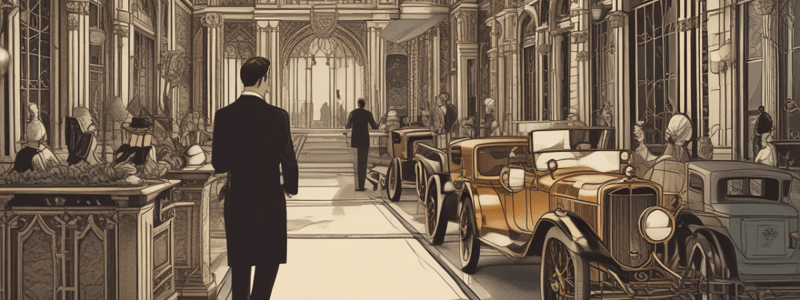Podcast
Questions and Answers
What is the primary characteristic of the 3rd person POV: Objective point of view?
What is the primary characteristic of the 3rd person POV: Objective point of view?
- The narrator has no emotional involvement in the story (correct)
- The narrator only describes the actions of one character
- The narrator is a character in the story
- The narrator has limited knowledge of the characters' thoughts
Which of the following stories is an example of 3rd person POV: Objective?
Which of the following stories is an example of 3rd person POV: Objective?
- A Clean, Well-Lighted Place
- To Kill a Mockingbird
- The Great Gatsby
- The Lottery (correct)
What is the significance of the post office and the bank in The Lottery?
What is the significance of the post office and the bank in The Lottery?
- They are the meeting points for the lottery (correct)
- They are the only buildings in the village
- They are the oldest buildings in the village
- They are the symbols of the village's prosperity
What is the tone of the dialogue between the waiter and his colleague in A Clean, Well-Lighted Place?
What is the tone of the dialogue between the waiter and his colleague in A Clean, Well-Lighted Place?
What is the common theme between The Lottery and A Clean, Well-Lighted Place?
What is the common theme between The Lottery and A Clean, Well-Lighted Place?
Flashcards are hidden until you start studying
Study Notes
Point of View
- Point of View refers to who is telling the story and how much they contribute to the narrative.
2nd Person POV
- Rarely used in literature.
- Uses "you" and presents commands.
- Often the narrator is speaking to him/herself.
- Example: "Wash the white clothes on Monday and put them on the stone heap..." (from Jamaica Kincaid's "Girl")
- Example: "You are not the kind of guy who would be a place like this at this time of the morning..." (from Jay McInerney's Bright Lights, Big City)
3rd Person POV
- Omniscient:
- The narrator can see into the minds of all characters.
- Has a godlike perspective, knowing everything past, present, and future.
- Example: "It was the best of times, it was the worst of times..." (from Charles Dickens' A Tale of Two Cities)
- Limited:
- The narrator can see into one character's mind.
- All characters have thought privacy except for one.
- Gives the impression of being close to the mind of that one character.
- Example: "The girl he loved was shy and quick and the smallest in the class..." (from Elizabeth Graver's "The Boy Who Fell Forty Feet")
- Objective:
- The narrator only describes what happens and does not enter characters' thoughts.
- Reports what happens and what the characters are saying, like a video camera.
- Does not add comment about how the characters are feeling.
- Does not comment on the mood of the setting.
- Example: "The morning of June 27th was clear and sunny, with the fresh warmth of a full-summer day..." (from Shirley Jackson's "The Lottery")
- Example: "You should have killed yourself last week," he said to the deaf man..." (from Ernest Hemingway's "A Clean, Well-Lighted Place")
Studying That Suits You
Use AI to generate personalized quizzes and flashcards to suit your learning preferences.




